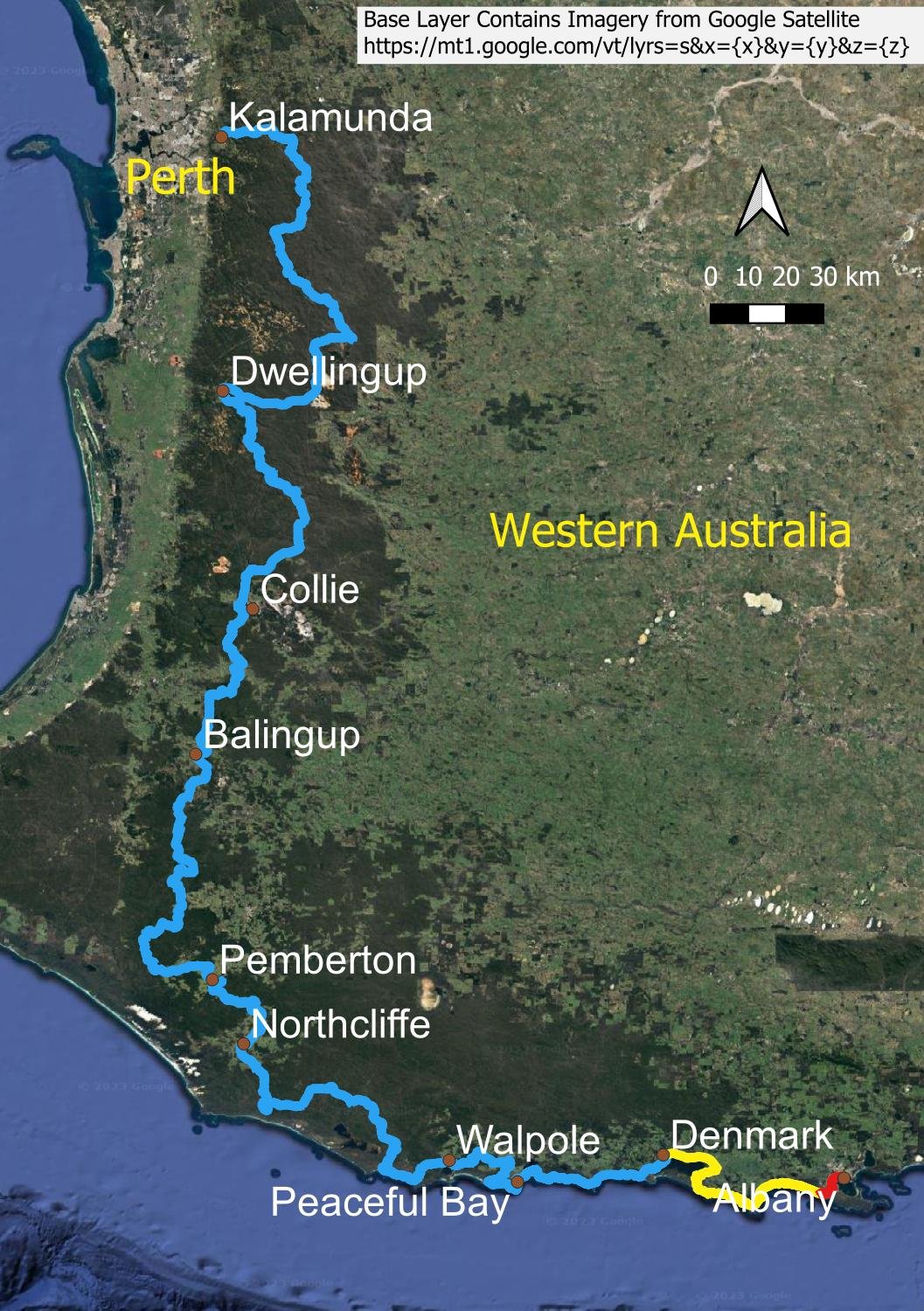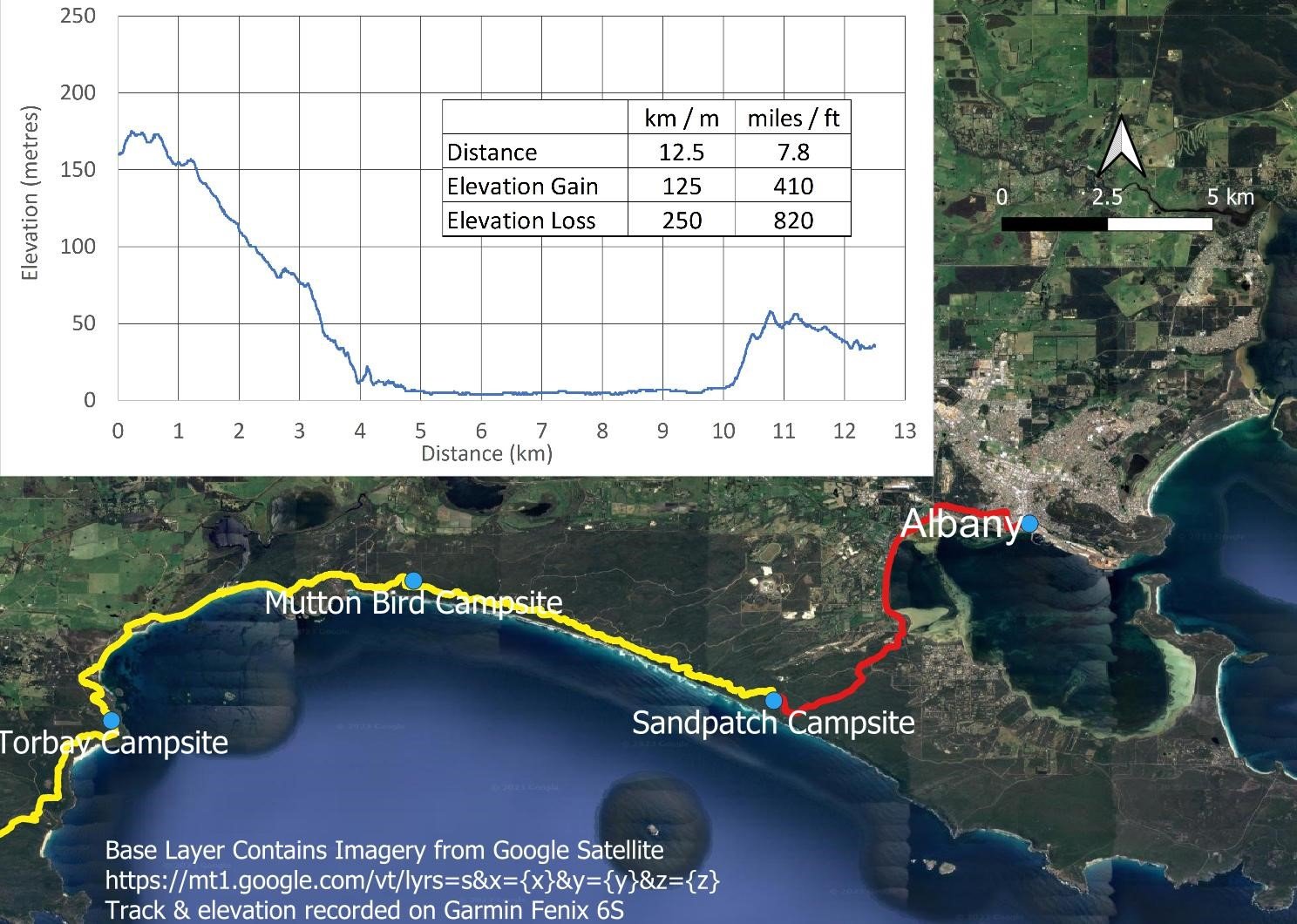Day 73: Sandpatch to Albany
We acknowledge the Nyoongar People as the traditional custodians of the land and waters along the Bibbulmun Track
A cruisy final day through lovely Torndirrup National Park, before following the western shore of Princess Royal Boat Harbour into the heart of Albany
Overview Map
Use Bibbulmun Track Map… wait there’s no need… if you can’t see Albany you’re going the wrong way!
Little elevation gain today, and just 12.5km.
You’ll have noticed we rarely take selfies. That’s because we know what we look like! But here is one with us packed up and about to leave Sandpatch as a memory of our last day. I’ve made a conscious effort to remember the things I’ve been missing, family and home and friends. We will see them all soon! First, though, we will enjoy these final hours.
The flowers remain gobsmacking. Even people who aren’t interested in plants will be amazed at the swathes of colour.
Back out to the sea, our companion for much of this journey. We have seen so many of her moods.
And a new Thelymitra, the Blue Lady Orchid (T. crinita) that we saw open yesterday (only closed buds today).
Here is Caladenia applanata ssp erubescens (Rose Spider Orchid), seen on preceding days. What a thrill! They are variable in colour, ranging from pale pink to deep red, and darkening as they age. During our first few weeks on the track near Perth, a northbound hiker told us about the fields of red spider orchids he’d seen between Denmark and Albany. I had almost given up, figuring that they would all have finished but hooray, there are just a few slackers still remaining! You won’t need to look hard for these as they are anything but cryptic!
Heading down with views across Princess Royal Harbour to Possession Point and Quarantine Hill. There is a grand hike on this long spit. Albany township is tucked just to the left out of shot.
A Bag-Shelter Moth (Ochrogaster lunifer) with its fox-fur stole. This is the adult form of a processionary caterpillar that you sometimes see marching nose to tail in long lines across the ground.
It is easy walking, with plenty of opportunities to reflect.
One of the most unexpected joys of the track is the friends we have made (indeed, since this day, we have returned to WA for visits with them). Thru-hiking has a levelling effect where social status and income are irrelevant. It imposes a unique intimacy that engenders a depth in relationships that normally takes much longer to develop, and we met many hikers who have become lifelong friends with those they met on the track. Nor is there anything forced about this. It just… happens… as you find like-minded Tramily. Thank you Oly and Virg, and Pat and Helen, for enriching our journey so much. And a shoutout to Simone and Ben, who became a team to be reckoned with!
Albany and a sit on another seat in a control burn area. We sit for at least ten minutes. Neither of us are talking much, both lost in our own thoughts.
Purple Coneflower (Isopogon formosus). We’ve seen so many of these, but I find myself trying to notice everything about this last day. It’s impossible, of course, not least because my memory isn’t great (so thank you, Diary!) but because there is just too much to take in.
Still plenty of beautiful forest. When we first started the Track, the plants were all unfamiliar. Now they are old friends.
Boardwalk along the edge of the Harbour.
You can’t hear it, but there’s a lot of traffic noise. Albany is a large town of 40,000 souls, about ten times bigger than any settlement we’ve passed through since we left Kalamunda in Perth. But the Track gently eases us back.
The cycle/walk track runs parallel to a road. Cars are rushing past. Soon we will be in town!
But not quite yet. We are right at the water’s edge.
Geoff and I are hang glider pilots, and to learn this sport you must also learn to successfully manage your fears. Thru-hiking is subtly different, although many of us do have specific fears, like snakes, or being alone, that might stop you having a go which need to be addressed (see how here).
I wondered whether my body, with many of life’s battlescars, would carry me such a distance. After cancer, it’s easy to lose trust in your body. You gain the gift of gratefulness, but pay in self-doubt and uncertainty. I wondered whether I could regain this confidence; it’s a motivation that I didn’t recognise until recently.
Happily, the answer is yes. Thru-hiking gives you space and time in your own mind, even when you are hiking ‘together-together’ with a partner, as Geoff and I do. Many of the hikers we met on the track were there to resolve personal issues. It is an excellent way to get to know yourself. I am… content. Thank you to Country.
Nearly everyone can walk. You need no special skills and thru-hiking is not rocket science. It requires a degree of determination (perhaps not as much as you might think), realistic expectations, and resilience. Understanding your own motivation is key.
Birds in the Harbour.
Another thing that has become blindingly obvious to us both is that there is no one way to thru-hike. Certain things, like minimising weight in your pack, and solid navigation skills, help most people but these pale to insignificance when compared to mental attributes and attitudes.
As well, don’t underestimate how much you will learn from others on the track: you will have gained all necessary skills and understand yourself better at the end. There is always someone with a fantastic solution that has not occurred to you! I’m grateful to the numerous hikers who gifted us with their knowledge.
A number of readers have asked us for a gear list and we will publish an article for you, but anyone else’s list will invariably not be perfect because they are not you. We met hikers with freestanding and non-freestanding tents, light and heavy packs, hikers who prepped all their food ahead of time and those who bought everything in track towns, hikers in sandals, boots, shoes and crocs hiking at our speed and quadruple our speed and everything in between, hikers who planned to the nth degree and those who winged it… and all completed their hike successfully.
A nice echo of the wild kangaroo paws we hiked through just out of Denmark. We are almost at the Visitor Centre!
A thru-hike will improve your cardiovascular fitness and it is a great option for older folk like Geoff and me because low impact exercise effortlessly becomes part of your day. It’s important to liten to your body, because such sustained exercise, even if it’s low impact, places significant loads on ageing muscles, joints and tendons, but there are nearly always workarounds if you catch issues early.
Here we are. Since then, we have hiked many more multiday hikes. It is another gift from the Track: 10-30 day hikes all seem perfectly achievable, even short, when done in our own way at our own slower pace. The Cape to Cape Track was straightforward.
And none of these gifts, gifts that every thru-hiker receives, would have happened without the Bibbulmun Track Foundation and their volunteers who together with DPaW build and maintain huts and the track, and build and maintain those wooden seats, and route the track over every bloody hill that you curse on the way up but then gratefully thank when the amazing view opens up before you. Thank you BTF vollies!
Ringing the Traditional Bell in the Visitor Centre. Or, as Geoff would say, “We Made It! Good Job!”





















